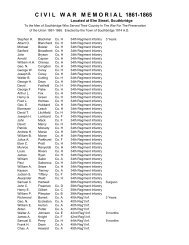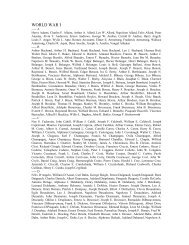Darryl Meister Technical Paper on Cyl Axis - Whitney Home Page
Darryl Meister Technical Paper on Cyl Axis - Whitney Home Page
Darryl Meister Technical Paper on Cyl Axis - Whitney Home Page
Create successful ePaper yourself
Turn your PDF publications into a flip-book with our unique Google optimized e-Paper software.
where θ is given by:<br />
F2<br />
⋅ sin 2α<br />
tan 2θ<br />
=<br />
F + F ⋅ cos2α<br />
1<br />
2<br />
Equati<strong>on</strong> 2<br />
Moreover, in our particular case—wherein the cylinder powers (F1 and F2) are equal in magnitude and opposite<br />
in sign—the equati<strong>on</strong>s can be simplified c<strong>on</strong>siderably. In this special case, the resultant cylinder power C<br />
produced by combining two cylinders powers of equal magnitude (F1), <strong>on</strong>e negative and <strong>on</strong>e positive, is given<br />
by: 3<br />
C = 2F1 ⋅sinα<br />
Equati<strong>on</strong> 3<br />
Equati<strong>on</strong> 3 is also the equati<strong>on</strong> for a Stokes Lens. This resultant cylinder power is essentially a residual<br />
refractive error produced by the misalignment of the cylinder axis of the spectacle lens with the prescribed axis.<br />
Furthermore, the mean power (or spherical equivalent) remains unchanged in this case, regardless of the<br />
original or resultant cylinder power. C<strong>on</strong>sequently, <strong>on</strong>ly the resultant cylinder power is meaningful.<br />
For instance, given a prescribed cylinder power of 2.00 D and an error in the prescribed cylinder axis of 5°, the<br />
resultant cylinder power error is:<br />
( 2.<br />
00)<br />
⋅sin5<br />
0.<br />
35<br />
C = 2 =<br />
C<strong>on</strong>sequently, an error from the prescribed axis of 5° produces a residual astigmatic (cylinder power) error of<br />
0.35 D. Therefore, the wearer acceptance of a sphero-cylindrical lens with an error in cylinder axis can be<br />
c<strong>on</strong>sidered in terms of its capacity to blur visi<strong>on</strong> as a normal power error would. In this example, the error in axis<br />
is essentially equal to an unwanted cylinder power error of 0.35 D.<br />
Establishing Tolerances <strong>on</strong> <strong>Cyl</strong>inder <strong>Axis</strong><br />
For the purposes of establishing prescripti<strong>on</strong> tolerances, we might ask how far the axis of a given cylinder power<br />
must be shifted in order to introduce an error in cylinder power equivalent to our normal (ANSI Z80.1) cylinder<br />
power tolerance. This would allow us to arrive at a reas<strong>on</strong>able baseline for establishing cylinder axis tolerances<br />
based up<strong>on</strong> the assumed visual significance of a comparable power tolerance, which has indeed been the<br />
historical approach to establishing cylinder axis tolerances. After rearranging the Equati<strong>on</strong> 3 to solve for the<br />
angle α, we have:<br />
= sin<br />
⎛ C ⎞<br />
⎜<br />
⎟<br />
⎝ 2F1<br />
⎠<br />
−1<br />
α Equati<strong>on</strong> 4<br />
Now, if we assume a tolerance in cylinder power of 0.13 D, which is the current Z80.1-1999 tolerance <strong>on</strong><br />
cylinder powers up to 2.00 D, we can solve the angle α as a functi<strong>on</strong> of cylinder power, as shown in Figure 1. 4<br />
Error in <strong>Cyl</strong>inder <strong>Axis</strong><br />
35<br />
30<br />
25<br />
20<br />
15<br />
10<br />
5<br />
0<br />
0.00<br />
<strong>Axis</strong> Error Required To Induce<br />
A 0.13 D <strong>Cyl</strong>inder Power Error<br />
0.25<br />
0.50<br />
0.75<br />
1.00<br />
1.25<br />
1.50<br />
1.75<br />
2.00<br />
2.25<br />
Prescribed <strong>Cyl</strong>inder Power<br />
Figure 1: Error in cylinder axis required to induce a 0.13 D cylinder power error<br />
2.50<br />
2.75<br />
3.00<br />
<strong>Page</strong> 2





